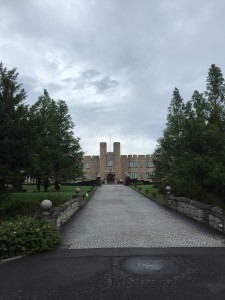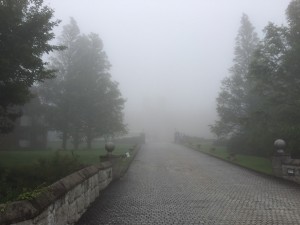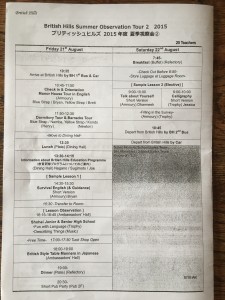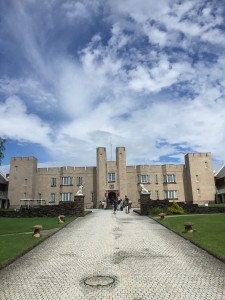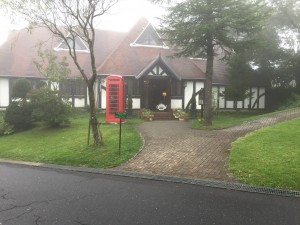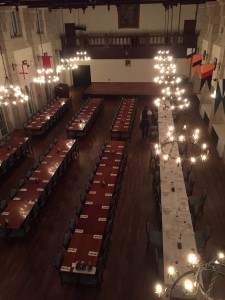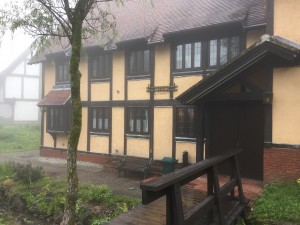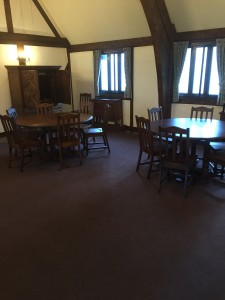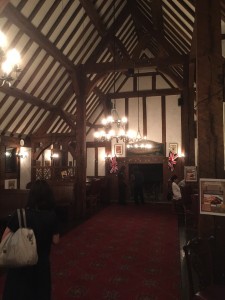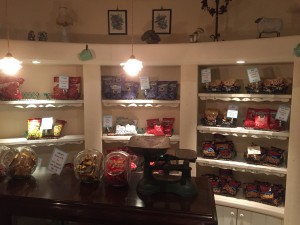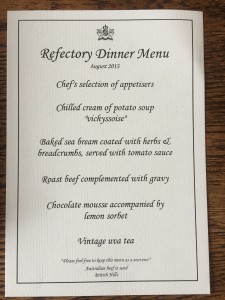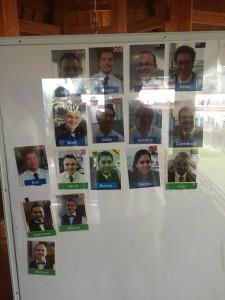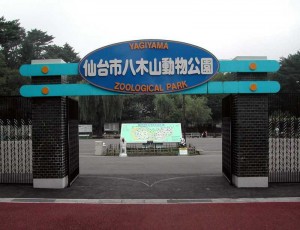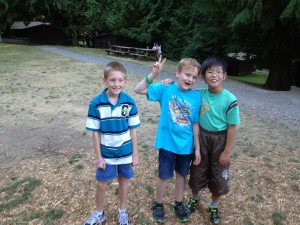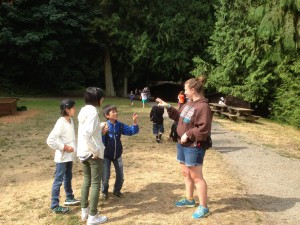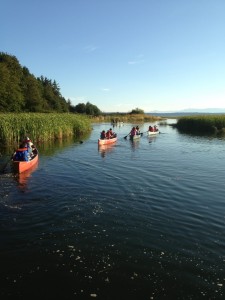business language courses school management study trips summer camp
by sendaiben
10 comments
British Hills in Fukushima
Some corner of a foreign field…
I finally had the chance to visit British Hills in Fukushima last weekend. If you are not aware of British Hills, it’s basically an ‘English village’ run by the Kanda Foreign Languages Group that doubles as a hotel and language training centre. They are located in the mountains of Fukushima, 25 minutes drive from the nearest convenience store!
The resort was running a special summer tour for teachers (basically a PR exercise) and I was able to join it alongside 28 other teachers. We spent about 24 hours there, arriving on Friday morning and leaving on Saturday morning. It was extremely interesting and worth doing if you are thinking about taking students there. The study visit costs about 12,000 yen, which basically covers the food and transport costs. Accommodation and lessons would be much more if you were paying (more on prices later).
Weirdly, we had British weather the whole time: misty and cool. The resort is in the mountains at 1000 metres altitude, so it’s much cooler than the surrounding area in summer. Apparently they get up to 2 metres of snow in the winter though!
The schedule for the visit
The event was extremely well run, and we had a number of the sales and management staff (including the President) come up from Tokyo to join in. To be honest, it was an extremely full schedule, and we felt a bit rushed. There was no time to walk around or relax on the tour.
The facilities
The buildings and grounds at British Hills are probably the best thing about the place. The whole complex is beautiful and is very ‘English’ in a stereotypical way. Lots of lawns and Edwardian houses. It definitely fulfills its role as ‘an English village in Japan’.
The main building housing classrooms, the Refectory (dining hall), swimming pool, gym, etc.
The tea shop, which we didn’t have time to sit down in but looked good.
The dining hall, modeled on an Oxbridge college Hall.
One of the student dorm buildings.
A common room in one of the student dorms.
The pub.
The tuck shop, which I was initially excited about, and then very disappointed with. None of the snacks are British!
Lessons
During the tour we were able to attend or watch the following lessons:
- Introductory lesson/orientation (English)
- Tour of main building (English)
- Tour of dormitories and main student building (Armory) (Japanese)
- Information about B.H. study programs (Japanese)
- Survival English (English)
- Lesson Observations (2) (English)
- British Table Manners (Japanese)
- Calligraphy (English)
My impression of what we saw is that the Japanese orientations (PR pitches) were pretty good, the content lessons in English and Japanese were very good, and the language lessons in English were pretty poor. The lessons I saw (which I presume are the best lessons) struck me as something a first-year ALT might do. Lots of running but most students are not doing anything for most of the time. I was expecting much more and this was the most disappointing aspect of the visit, particularly as students pay 3000 each for these lessons, so with a full class of 20 you are paying 60,000 yen to have students do criss-cross for 90 minutes.
The calligraphy lesson we took was very good, as was the lecture on table manners. I imagine the cooking lessons would also be fun.
Based on what I saw, the language lessons are not worth doing, but the culture and craft ones might be.
Food
We had three meals on site.
Lunch was fine. It was filling, hearty, inoffensive, and kind of British.
Dinner was excellent.
Breakfast was fine, buffet-style like a hotel. Not great quality but filling.
Staff
The staff were without exception all great. Friendly and welcoming, there was a really nice atmosphere throughout the site.
Some of the teaching staff.
Apparently there are twenty-three foreign teaching staff, and twenty other foreign staff on site. As the resort is open all year round, they presumably are working shifts and taking holidays. My impression is that there were not as many foreign staff as I was expecting. To be honest, they were kind of thin on the ground. British Hills, at least while I was there, did not deliver the kind of English immersion I was expecting.
The resort did have Japanese staff that were doing their best to interact with visitors in English, but the few interactions I witnessed seemed a bit forced and the resort staff’s English was not perfect, even when dealing with junior high school students. Of course, this would not be important outside of the context of an English immersion experience.
Overall though, the friendliness and warm atmosphere was a credit to the resort.
Prices and Location
Now this is the killer. The resort is located about 40 minutes drive from Shin-Shirakawa shinkansen station. The resort operates shuttles, but I’m not sure if you have to pay for them. From Sendai, it’s basically two hours door-to-door by shinkansen, or three and a half by coach.
The prices, both to stay and for lessons, seem a bit high to me. The resort has a high season (July to September) and a low season (the rest of the year). Prices are slightly lower in the low season. There are also different prices for schools, universities, individuals, and groups. It’s all very confusing.
My impression is that it will cost 15,000+ yen to stay and 3000-5000 yen per class per student. They seem to be empty in the winter, so it may be possible to negotiate a better deal then.
Overall
I was both impressed and unimpressed with British Hills. The facilities are amazing, the staff are really friendly, it’s inconvenient to get to, the prices are a bit too high for accommodation and ridiculous for lessons, and the language lesson quality is poor.
Overall I would not write it off, but you would have to be very careful when designing your program to make it worthwhile. I get the feeling their standard packages would be a poor value.
It was an interesting couple of days though. Thank you British Hills for the invitation and the hospitality, and hopefully I’ll have a chance to take some students there at some point.
Has anyone else visited British Hills? How was it?
business eikaiwa kids school management study trips summer camp young learners
by sendaiben
leave a comment
Eikaiwa School Field Trips: Summer at the Zoo
Every year we organize some kind of optional summer event for our students. Past events have included ice skating (feels weird to put on sweaters and gloves in August!), outdoor games, playing in a river, and trips to the seaside. This year we decided to go to Yagiyama Zoo in Sendai with our preschool- and elementary school-aged students.
Before the trip we visited the zoo to plan out routes and activities, bought small sketchbooks for all the students, divided them into groups and assigned teachers to lead each group.
There was a slight problem with the timing of the announcement coinciding with the school being closed for some classes, so that some parents only got the announcement letter after the trip was full! We did our best to accommodate them which led to us needing a larger bus and the groups getting a bit too big for the number of teachers we had (several were away due to the summer holidays).
Then the day before the excursion the weather reports changed from sunny with cloudy spells to rain (60%). Then that evening rain (70%). The next morning the ground was wet when we woke up at six am, but by seven it was raining. By eight thirty (the deadline for making a decision) it was raining heavily.
Fortunately we had a plan B. We had made arrangements to go to the aquarium at Matsushima in the event of rain. This was not ideal, but preferable to cancelling and being out of pocket for the bus hire and other expenses.
The problem with the aquarium is that we hadn’t had time to visit and make plans. It was also much more expensive than the zoo, and smaller. We weren’t sure if there was enough to do there for the four hours we had planned.
Lessons Learned
We learned a lot from this year’s trip. Here are some of the most important things:
1. Having a plan B is essential if weather could impact on your trip. What were the chances of the only rainy day for weeks and weeks being the day we were going to the zoo? Because we had a plan B and had told the students and parents about it our trip wasn’t ruined. However, we should have put more time into getting ready for plan B.
2. Accurately estimating demand, making sure the sign-up process is fair to everyone, and sticking to deadlines and limits on numbers of students is important. We didn’t have any major problems this time, but the large numbers of students made things more difficult for our teachers (I found myself supervising sixteen young children for much of the day, and it was too many for comfort).
3. The number of seats quoted by bus companies include those fold-down seats in the middle. I don’t like them because they are uncomfortable, seem less safe, and mean that it is not possible for teachers to move around the bus when they are in use. In the future, I would like to make sure all the students have a proper seat, with only teachers in the middle seats if necessary.
Conclusion
In the end the trip turned out well. The aquarium had just enough to keep us busy (looking at the fish, drawing pictures, watching the sealion show, shaking hands with a sealion, meeting baby turtles, wading in a big pool, etc.). It was also great that they had a large seating area that wasn’t at all busy, so we could sit the students down in groups and talk to them, have them draw pictures, and eat lunch in an orderly fashion.
I think we were both unlucky (the weather) and lucky (everything turned out fine and the students enjoyed themselves). We also got a few insights for next year.
Does anyone else do field trips?
business curriculum eikaiwa ES expectations JHS junior high school kids language courses Language learning overseas study trips school management summer camp young learners
by sendaiben
2 comments
Taking students to summer camp in the US
This is a guest post (the first on this blog!) by a friend of mine, Ryan Hagglund. He has an extremely promising variation on the usual study abroad trip that I thought you would find interesting. Enjoy and let us know what you think in the comments.
After many years of thinking about it, we finally took students from our school (MY English School in Yamagata) to the US for the first time this summer. Thanks to all the advice and stories I read and heard from others, the trip was overall a success and will hopefully serve as a building block for many more to come.
My impression is that most international trips English schools organize involve some form of formal study. While there is obviously nothing wrong with studying—we ARE a language school—it seems like there’s plenty of time for the students to study while in Japan. The main purpose for us in going was to give the students something they couldn’t receive here: the opportunity to interact with large numbers of English-speaking children of their own age. We wanted to give them an experience that would lead to greater motivation and increased interaction skills, among other things. The instrument we chose to accomplish this was to have the children attend a summer camp intended for children who are native speakers of English, not English learners.
We chose Warm Beach Camp in Stanwood, Washington. We chose Warm Beach for several reasons. First, it is the camp I attended when an elementary and JHS student, so I was familiar with the facilities. Having attended almost 30 years ago, however, I no longer had connections to any of the staff. Second, it is a large facility that not only has many activities for campers to do, but was also able to house our staff away from our students but still onsite. Third, it gave considerable value for the price. Camp was only US $399 per student for six days and five nights—including meals—and they supplied free room and board for our staff in a separate onsite facility. They also provided free sleeping bags and pillows to our students. (Warm Beach is a Christian camp facility, but we were careful to make sure our students and their parents were aware of this. There are most likely secular camps with similar facilities and value.)
We took five students—two boys and three girls—ages 9-13 (Japanese elementary 4th grade to JHS 2nd year). There were approximately 80 campers all together ages 9-11 (US 4th to 6th grade) divided into cabins of six or seven students each. Our 13-year-old student had no problems relating to the younger campers, though JHS 1st year would probably be a good cutoff. Since none of the US campers nor counselors spoke Japanese, the students had to navigate in English. What was nice, however, were the many activities the children were able to participate in, allowing them to interact in English without consciously having to overly focus on the language itself. Some of the activities they participated in were: field games, swimming, archery, horseback riding, canoeing, wall climbing, BB-gun shooting, mini-golf, and a bonfire. While it was challenging for them at first, by the end of the trip four of the five students said they would like to stay longer. The fifth (12 years old) said she was glad to have come, but just ready to go home. We were only with the students for a daily meeting each evening, when pre-activity safety instructions in Japanese were necessary, and when a student became homesick and needed a little extra support. We had a pre-paid US cell phone so the camp and/or counselors could reach us at any time if necessary. They only called us once.
While the camp was our focus, we did do other activities as well. Our schedule was as follows:
Saturday Aug 3 – Arrive in Seattle and tour the city
Sunday Aug 4 – Visit Wild Waves Theme Park
Monday Aug 5 – Saturday Aug 10 – Attend camp and Seattle Mariners baseball game (Aug 10)
Sunday Aug 11 – Return to Japan
We will probably add an additional day of Seattle sightseeing if we go again next year.
Camp positives:
1) No need to be concerned about the quality of homestay families.
2) No need to worry about logistics for most of the trip. While at the camp, we were able to focus entirely on the students’ linguistic and emotional needs, while enjoying ourselves for most of the time. The camp took care of the rest.
3) No need to think of specific language activities, as the situation itself required meaningful English interaction from our students.
4) The camp wanted the trip to be successful as much as we did.
5) No need to pay a third party for special arrangements.
6) Students needed very little spending money. Each student brought 20,000 yen in spending money, but none of them came close to using it all.
7) Since almost everything was included in the camp price, there were fewer opportunities for financial surprises.
8) 24-hour onsite certified nurse, removing the need for us to worry about student sickness and/or injury.
Camp possible negatives:
1) We did have to plan the logistics outside of camp time. This included airline booking, three nights of hotel, sightseeing in Seattle, and transportation to and from the camp. While not difficult, might be hard to leave to a school teacher or staff member not familiar with the Seattle area.
2) Not as appropriate for students who would prefer a “travel experience” versus an “immersion experience”.
All in all, it was a very successful trip—especially for a first time. We are already working to produce marketing materials for a similar trip next year.
Ryan Hagglund is President and CEO of MY English School in Yamagata Prefecture. He has lived in Japan for 15 years and originally hails from the Pacific Northwest. He is married to Maki Hagglund and has three children: Aiden (8), Ian (6), and Sean (4).
Summer camp
We did our first day summer camp with our students last year. We joined a camp run by another school, and went off to a nearby island with them to play on the beach, have a barbecue, and do lots of small English games.
We learned a lot from the experience, not least that it is not particularly difficult to organise ‘English’ events. I liked a lot of what they did (putting students in mixed-age teams, having low-pressure competition throughout the day, being active, going outside), but found some of it less effective (forcing English onto students, some of the activities).
We organised our own summer day camp this year, and it was a huge success. Students and staff had a good time, it didn’t take all that much preparation, and I think it will help our schools’ reputation.
I’m going to list some of the things that went well below, in the hopes that it will be useful for other teachers or school owner/operators.
1. We found a company to do most of the work that does outdoor activities for kids’ groups like neighbourhood associations, etc. and they were able to provide a morning activity (making zunda mochi), lunch, bus there and back, and a beautiful outdoor location for a very reasonable price (1700 yen per person). This took almost all the pain out of the experience and meant that we just had to organise our students and think of some games to play in the afternoon. If we had had to provide lunch and arrange transport, it would have been much more work.
2. We had students from various classrooms and classes, so mixing them up was a priority. We made mixed age and ability teams, and had two teachers and fourteen students in each. This worked well, and after about ten minutes into the zunda mochi making you couldn’t really tell which students were in the same class and which had just met for the first time.
3. We had a lot of staff, mostly parents and university student volunteers. This really helped with logistics (helping the students do things and carrying stuff mostly).
4. We had a mix of structured activity and free time, which meant the students had a chance to play soccer with their friends if they wanted, but didn’t really have time to get bored.
5. The emphasis was not really on English (some of the students brought friends who were not studying English) but rather on having fun together and getting to know each other. This removed a lot of the pressure, and resulted in a much more relaxed atmosphere than the camp last year (where there was much more emphasis on English, to the extent of the safety briefing being done in English!).
The best thing about the day was the chance to just hang out with the students and run around outside. I think everyone enjoyed the day and made some new friends.
I am hoping to do more activity days like this, again not based on English so much as having a fun day out with friends. That way we can build our school community further.
